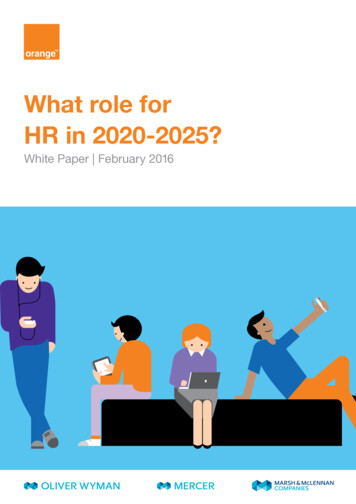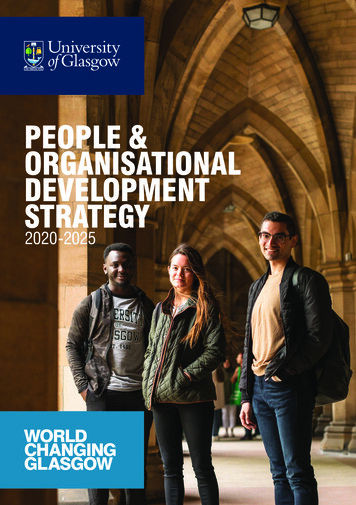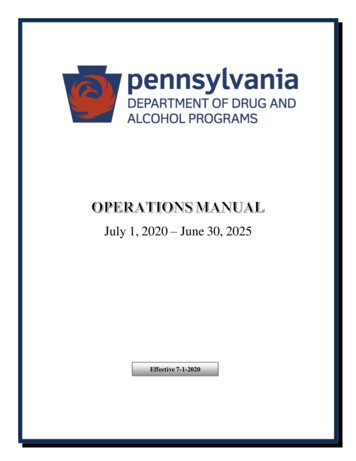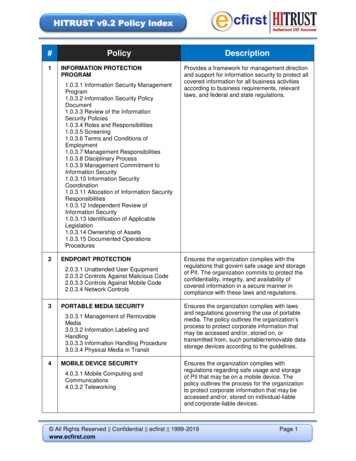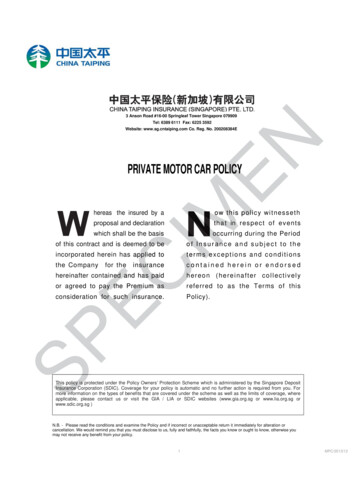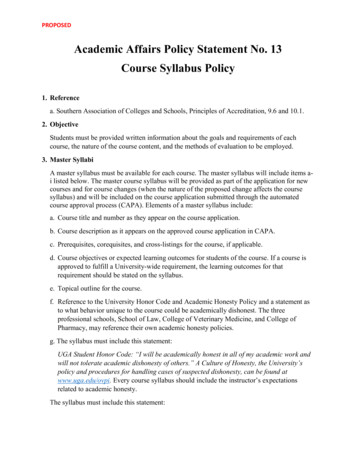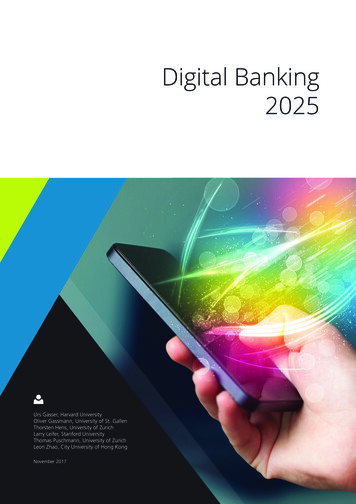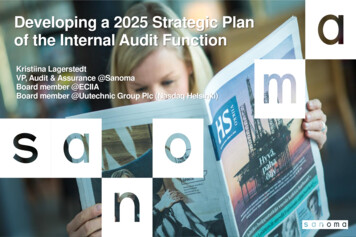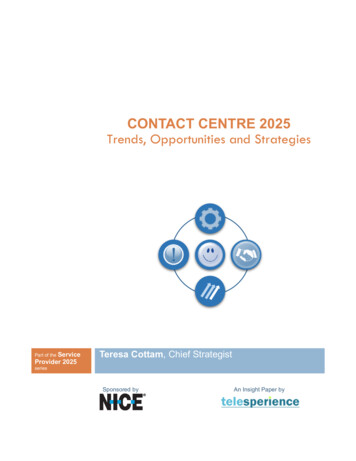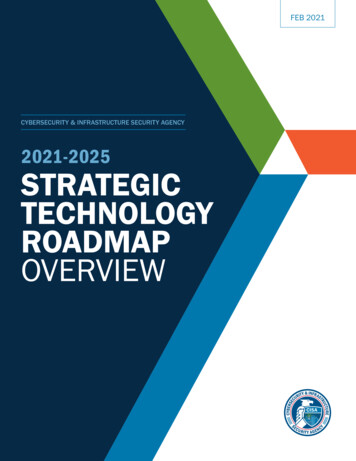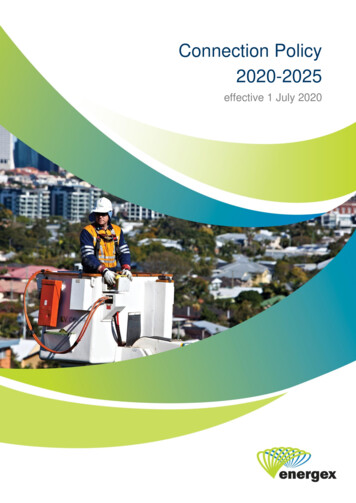
Transcription
Connection Policy2020-2025effective 1 July 2020
Contents1234Introduction . 21.1About Energex . 21.2Purpose and scope of document . 21.3Connecting to the Energex distribution network . 21.4Supporting and technical documentation . 31.5Contact details . 3Classification of customer connections . 42.1Small customer connections. 42.2Major customer connections. 6Connection offers . 83.1Basic connection offer . 93.2Standard connection offer . 103.3Negotiated connection offer. 11Charges for connection services . 124.1Basis for determining charges for connection services . 124.2Connection charges for alternative control services. 124.3Capital contributions for standard control services . 134.4Pioneer scheme for customer funded network extension assets . 184.5Security fee . 214.6Payment of connection charges . 225Contestability of services . 246Dispute resolution. 257Glossary . 267.1Abbreviations . 267.2Definitions . 26Energex Connection Policy 2020-20251
1Introduction1.1About EnergexEnergex Limited (Energex) is part of the Energy Queensland Group. Energex manages an electricitydistribution network that delivers world-class energy products and services to one of Australia’sfastest growing communities – the South-East Queensland region. Energex has been supplyingelectricity to Queenslanders for more than 100 years and today provides distribution services toalmost 1.4 million domestic and business connections, delivering electricity to a population base ofaround 3.4 million people via 52,000 km of overhead and underground network.1.2Purpose and scope of documentThis document is Energex’s connection policy for the regulatory control period from 1 July 2020 to30 June 2025. It sets out the nature of the connection services offered by Energex during this period,and the charges that may apply for those connection services.This policy has been prepared in accordance with Part DA of Chapter 6 of the National ElectricityRules (the Rules), which requires distribution network service providers to prepare a connectionpolicy setting out the circumstances in which a retail customer or real estate developer may berequired to pay a connection charge for the provision of a connection service under Chapter 5A of theRules. This document is also consistent with: the connection charge principles described in Part E of Chapter 5A of the Rules; the “Connection charge guidelines for electricity retail customers” published by theAustralian Energy Regulator (AER); and the AER’s Framework and Approach decision for the proposed classification of services forthe 2020-2025 regulatory control period.This policy does not apply to Registered Participants or intending Registered Participants seeking toconnect to Energex’s distribution network under Chapter 5 of the Rules.1.3Connecting to the Energex distribution networkA connection is the physical link between a distribution system and a customer’s premises to allowthe flow of electricity. All customers will require network connection services to connect theirpremises to the Energex distribution system. Typically, a meter is also required in order to measurethe amount of electricity that flows through the connection.1.3.1Connection services provided by EnergexAs a distribution network service provider, Energex is responsible for providing connection servicesto customers to physically connect their premises to the Energex distribution network. Theseservices include: connecting new premises to the distribution network (new connections);Energex Connection Policy 2020-20252
making alterations to existing connections where those existing connections are no longerable to meet customers’ requirements, e.g. increasing the number of phases that supply apremises, relocating the incoming supply to a premises or changing from an overhead toan underground service (connection alterations); and establishing micro-embedded generator and embedded generator connections (which maybe either new connections or connection alterations).The provision of connection services may involve the establishment or modification of assetsdedicated to the particular customer (connection assets), as well as extensions to, or augmentationsof, the shared distribution network. An extension of the distribution network is where the presentboundaries of the distribution network need to be extended to include a new power line or facility. Anaugmentation of the distribution network is where work is required to enlarge the existing network orincrease its capacity to distribute electricity, e.g. by installing a larger transformer.Charges for connection services will typically depend upon the customer connection type and theclassification of the customer connection services required to make the connection.1.3.2Installation of metersApart from certain very limited cases where an unmetered connection is appropriate, customersconnecting to Energex’s distribution network will require a meter to measure the flow of electricityacross the connection point, both for billing purposes and to access other services.Energex is not responsible for installing or replacing meters at customers’ premises. Instead, it is theresponsibility of the customer’s nominated electricity retailer to appoint a metering coordinator toprovide this service, except where a customer has appointed their own metering coordinator.1Consequently, charges for new and replacement metering installations are the responsibility of thecustomer or their electricity retailer and are not discussed in this policy.1.4Supporting and technical documentationThis connection policy should be read in conjunction with Energex’s connection manuals andtechnical standards. Current versions of these documents, as well as further information on theconnection application process and applicable charges, are available on the Energex website:www.energex.com.au.1.5Contact detailsYou can contact our customer service centre via our website: www.energex.com.au; or by calling:13 12 53.1Business customers who consume electricity at or above the upper consumption threshold of 100 MWh per annum areclassified as large customers in Queensland and are able to appoint their own metering coordinator.Energex Connection Policy 2020-20253
2Classification of customer connectionsIn discussing connection services and charging arrangements, this policy refers to two types ofcustomer connections, namely: small customer connections; and major customer connections.The relevant type is determined by Energex based on the levels of expected energy consumptionand generation, using information provided by the connection applicant in accordance with Energex’sprocesses and procedures.2.1Small customer connectionsSmall customer connections are for those customers that fall within the Standard Asset Customer(SAC) tariff class under Energex’s Annual Pricing Proposal, which is available on our website.2Small customer connections typically include the connections of: residential dwellings and small commercial premises coupled and connected at low voltage orcoupled at high voltage and connected at low voltage where the installed capacity is less than1,000 kVA (1 MVA); unmetered supply connections; and micro-embedded generating units (as defined in Australian Standard AS/NZS 4777 “Gridconnection of energy systems via inverters”) with an installed capacity of less than or equal to30 kVA e.g. solar, thermal or wind powered systems, energy storage (e.g. batteries), or hybridsystems (e.g. solar PV plus batteries).Most small customer connections will only require standard connection assets which Energex mustprovide.3 However, in some instances, there may need to be changes to the existing connectionassets, or an extension to, or augmentation of, the shared distribution network.2.1.1Residential and small commercial premisesSmall customer connections are typically for residential customers and small commercial premises.The connection will involve either a low voltage overhead service connection or a low voltageunderground service connection, depending on whether the distribution network in the customer’sarea is overhead or underground.Refer to Energex’s Annual Pricing Proposal for full details of eligibility criteria for the SAC tariff class.Section 14(3) of the Electricity Regulation 2006 (Qld) provides that the maximum length of a service line required to beprovided and installed within a customer’s premises by an electricity entity at the electricity entity’s cost is: (a) 20 m for anoverhead service; and (b) 7 m for an underground service line.23Energex Connection Policy 2020-20254
Underground and overhead service lines and associated equipment are typically dedicatedconnection assets used to connect a particular customer’s electrical installation to the shareddistribution network.For premises located in an area with overhead power lines, the connection typically involves anoverhead service wire and service fuses from an Energex-owned pole to a connection point on thecustomer’s property. This is illustrated in the following diagram.Figure 1: Typical overhead connection for residential customerFor premises located in an area with underground electricity supply, the connection typically involvesthe customer’s consumer mains connecting into a connection point in an Energex-owned distributionservice pillar. The customer is then responsible for the consumer’s mains. This is illustrated in thefollowing diagram.Figure 2: Typical underground connection for residential customerEnergex Connection Policy 2020-20255
2.1.2Unmetered supplyEnergex offers unmetered supply connections in certain circumstances when it is consideredimpractical to read or maintain a meter or where metering equipment would be susceptible todamage. Connections that are eligible for unmetered supply are typically small, but must have asteady and uniform load, i.e. where the energy consumption can be accurately assessed without theneed for a meter. Unmetered supply connections are generally provided for facilities such ascustomer-owned and operated street lights, bus shelters, watchman lights, illuminated signs, securitycameras or traffic monitoring equipment.2.1.3Micro-embedded generating unitsAn embedded generating unit is an electricity generator that is connected to the distribution network(rather than the transmission network) and which may export electricity back into that distributionnetwork. This term includes micro-embedded generating units that are connected to the network viaan inverter and are defined in Australian Standard AS/NZS 4777 (generally up to 200 kVAcapacity). Micro-embedded generating units include solar, thermal or wind powered systems, energystorage (e.g. batteries), or hybrid systems (e.g. solar PV plus batteries).The connection of one or more micro-embedded generating units is a small customer connectionwhere the aggregate capacity of the generating units is less than or equal to 30 kVA. These microembedded generating units must comply with Energex’s technical standards which can be found onour website.2.2Major customer connectionsMajor customer connections are defined in Energex’s Annual Pricing Proposal as those connectionsthat fall within the tariff classes of Connection Asset Customer (CAC) and Individually CalculatedCustomer (ICC),4 embedded generators and real estate developments. Major customer connectionswill typically include: large commercial premises coupled at high voltage or sub-transmission with an installedcapacity of greater than 1,000 kVA (1 MVA); micro-embedded generating units with an installed capacity of greater than 30 kVA; non-registered embedded generators (i.e. with an installed capacity of greater th
1.5 Contact details You can contact our customer service centre via our website: www.energex.com.au; or by calling: 13 12 53. 1 Business customers who consume electricity at or above the upper consumption threshold of 100 MWh per annum are classified as large customers in Queensland and are able to appoint their own metering coordinator. Energex Connection Policy 2020-2025 4 2 Classification .

